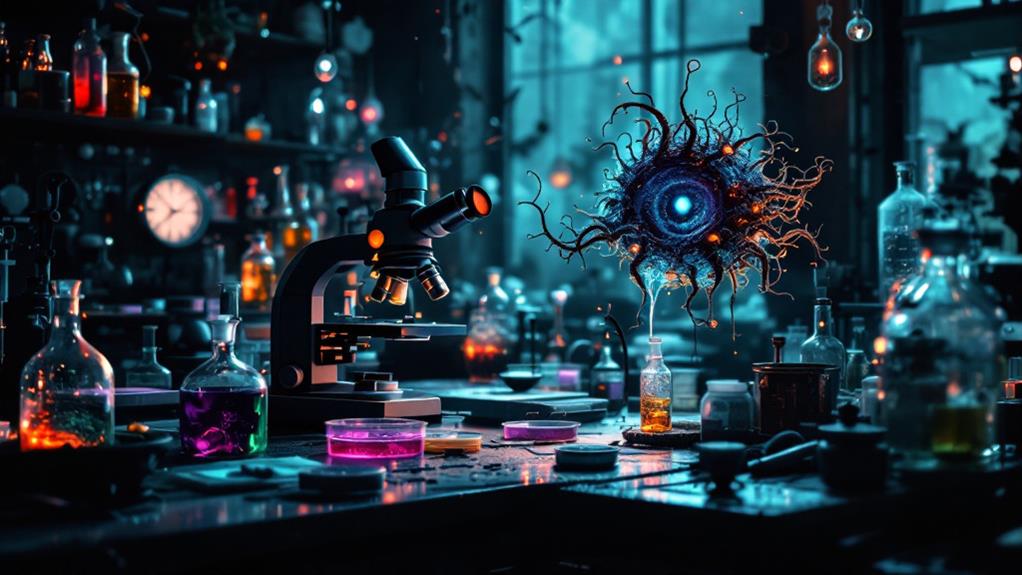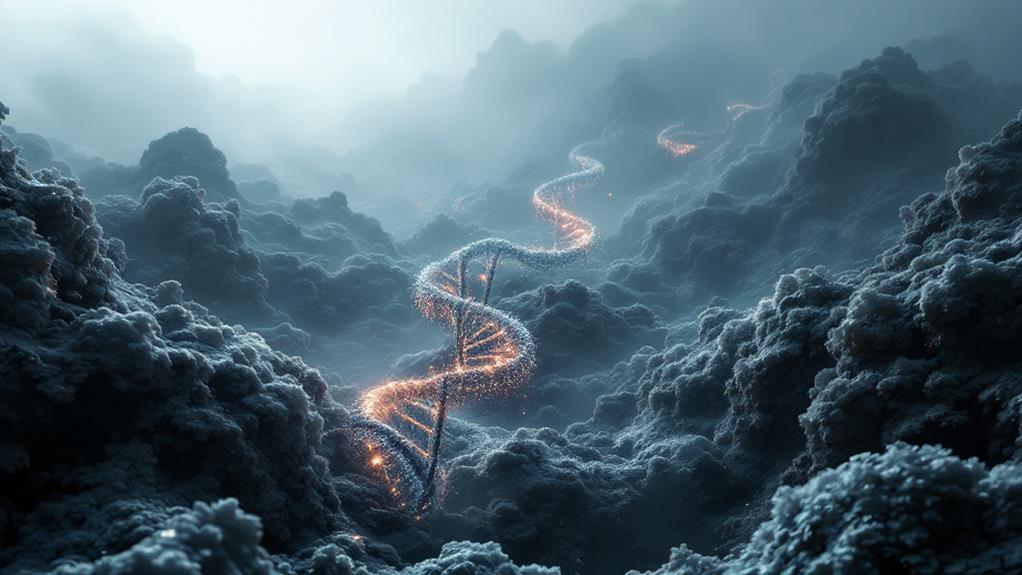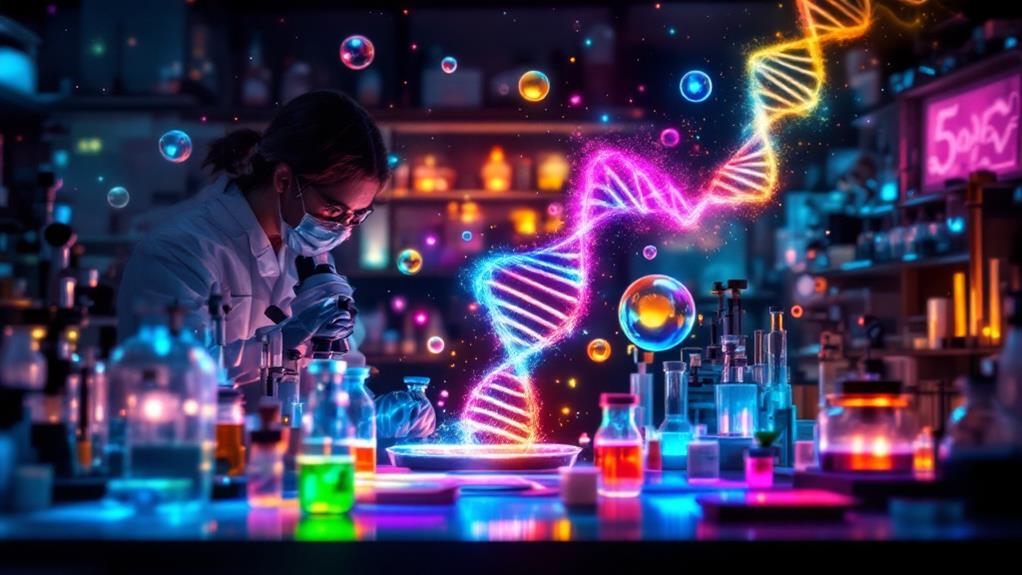Mysterious Diseases: Rare Conditions You’ve Never Heard Of

You might be surprised by diseases like Stoneman Syndrome, where connective tissues turn into bone, severely limiting mobility. Or consider Alice in Wonderland Syndrome, which warps your perception of size and distance, often alongside migraines. Ever heard of Foreign Accent Syndrome? It leaves people with a sudden new accent after a brain injury. Then there's Hutchinson-Gilford Progeria, causing children to grow older rapidly with a short life expectancy. Alkaptonuria, another rare condition, turns urine and tissues dark due to an enzyme deficiency. These mystifying conditions are just the tip of the iceberg, each with its own complex challenges and stories.
Uncommon Medical Mysteries
In the domain of uncommon medical mysteries, some conditions defy logic and challenge the boundaries of medical science. You've probably never imagined connective tissue turning into bone, but that's exactly what happens with Stoneman Syndrome, a rare disease affecting 1 in 2 million people. This rare genetic disorder gradually restricts movement, leaving individuals facing severe mobility challenges. Then there's Alice in Wonderland Syndrome, where your perception of size and distance gets distorted, often linked with migraines and lacking a specific treatment.
Hutchinson-Gilford Progeria is another rare genetic disorder, causing rapid aging in children. With a prevalence of about 1 in 4 million, it drastically shortens life expectancy, typically to the mid-teens or early twenties. Alkaptonuria, impacting 1 in a million, leads to the buildup of homogentisic acid, resulting in dark-stained urine and tissues, yet offers no effective treatment.
Foreign Accent Syndrome, although a rare neurological condition, might suddenly change your speech accent after a brain injury, presenting unique social hurdles. These extremely rare diseases underscore the urgent need for medical research, pushing us to investigate the unknown and seek solutions for these enigmatic conditions.
Rare Neurological Disorders
Imagine waking up one day to find your speech suddenly adopts a foreign accent, or feeling as if your body parts are missing. These scenarios are reality for those with rare neurological disorders like Foreign Accent Syndrome and Walking Corpse Syndrome (Cotard's Syndrome). Foreign Accent Syndrome, a rare condition, causes sudden speech changes, often after a neurological event like a stroke, leaving you with a new accent. Meanwhile, Cotard's Syndrome leads you to believe you're dead or missing body parts, causing severe delusions and possibly self-harm, with therapy and medications as primary treatments.
Alice in Wonderland Syndrome (AIWS) distorts your perception of size and distance, making objects seem larger or smaller than they are, often linked with migraines. Your body image also becomes distorted, yet there's no known specific treatment for this intriguing disorder. Rasmussen's Encephalitis strikes primarily in children, provoking severe seizures and cognitive decline due to brain inflammation, causing progressive damage over months without a definitive cure.
Stiff Person Syndrome triggers intense muscle stiffness and spasms, affecting about 1 in 1 million people. Often mistaken for other conditions, it demands treatments like muscle relaxants and immunotherapy to manage symptoms.
Genetic Anomalies Explored

While rare neurological disorders mystify us with their peculiar symptoms, genetic anomalies likewise intrigue with their profound impact on human health. These genetic conditions can lead to a variety of rare inherited diseases, with around 80% having a genetic component. Progeria Syndrome, for example, affects 1 in 20 million individuals and accelerates aging in children due to mutations in the LMNA gene. This disorder is extensively documented in scientific literature globally, highlighting its devastating consequences.
Alkaptonuria, also known as Black Urine Disease, impacts between 1 in 250,000 to 1 in 1 million people. It results from a deficiency in the enzyme homogentisic acid oxidase, causing harmful accumulation of homogentisic acid. Fibrodysplasia Ossificans Progressiva, or Stoneman Syndrome, affects 1 in 2 million individuals. This genetic anomaly causes connective tissues to transform into bone, known as heterotopic ossification.
These rare conditions underscore the complexity of genetic anomalies and their profound effects on those affected. Each disorder presents unique challenges and insights into human biology, emphasizing the critical need for continued research and awareness. Understanding these anomalies helps unravel the mysteries of our genetic makeup.
Unusual Psychological Conditions
Investigate the intriguing world of unusual psychological conditions, where the mind's mysteries often leave us astounded. Walking Corpse Syndrome, known as Cotard's Syndrome, is a disorder that causes people to believe they're dead or missing body parts. This severe delusion can lead to dangerous self-harm, highlighting the complexity of the human brain. Proper treatment typically involves a combination of therapy and medication to stabilize the individual's mental state.
Persistent Sexual Arousal Syndrome is another condition where the body reacts with constant arousal, unrelated to actual desire, leading to anxiety and insomnia. People experiencing this often require symptom management to regain some control over their lives.
Alice in Wonderland Syndrome (AIWS) distorts perceptions of body image and size, making everyday objects appear larger or smaller. It's often linked to migraines, yet the exact cause remains elusive, and there's no specific treatment available.
Foreign Accent Syndrome can surprise you after a minor brain injury or stroke, suddenly giving you a different accent. This unexpected change can cause social difficulties, but speech therapy offers a pathway to recovery. Ultimately, Stendhal Syndrome evokes overwhelming emotions in response to art, underscoring the powerful psychological impact of aesthetic beauty.
Emerging Research on Rare Diseases

As we unravel the mysteries of unusual psychological conditions, the domain of rare diseases calls with its own challenges and hopes. You might be intrigued by ongoing genetic studies aiming to reveal the genetic roots of rare conditions like hypertrichosis. These studies could lead to better diagnosis and treatment options, transforming lives. Cutting-edge therapies are on the horizon, with clinical trials exploring potential treatments for rare diseases such as Hutchinson-Gilford Progeria Syndrome (HGPS).
The National Organization for Rare Disorders (NORD) plays a crucial role by highlighting over 1,300 rare diseases in its database. By encouraging research collaborations among medical professionals, they aim to improve both diagnosis and treatment. Advances in technology, like gene editing and personalized medicine, offer promising solutions. By directly targeting genetic roots, these technologies could make previously untreatable conditions manageable.
Public funding is another critical factor, having increased to speed up the identification of cures. This financial support aims to improve the quality of life for individuals affected by rare conditions. Emerging research in this field offers a guiding light of hope, promising significant advancements and a brighter future for those impacted by these mysterious diseases.


